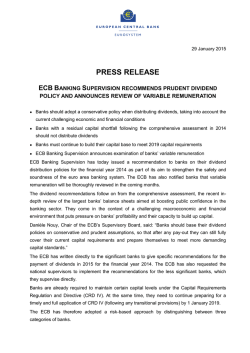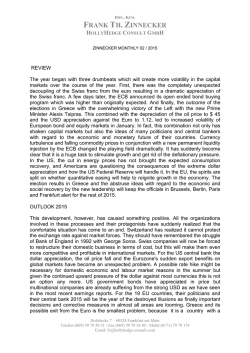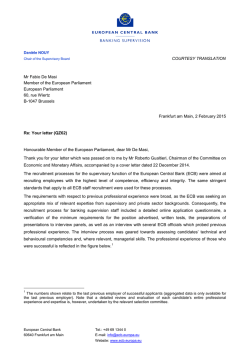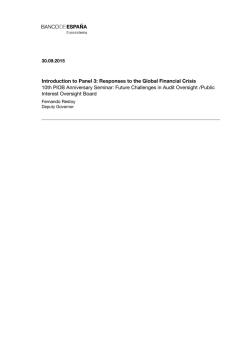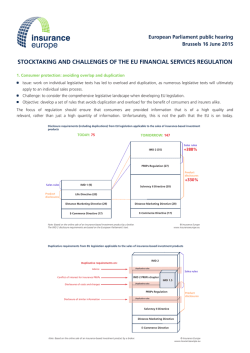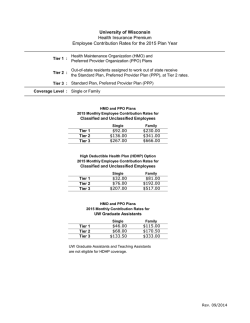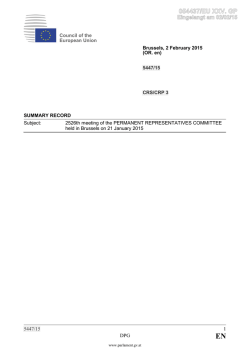
Recommendation on dividend distribution policies (ECB/2015/2)
EN ECB-PUBLIC RECOMMENDATION OF THE EUROPEAN CENTRAL BANK of 28 January 2015 on dividend distribution policies (ECB/2015/2) THE GOVERNING COUNCIL OF THE EUROPEAN CENTRAL BANK, Having regard to the Treaty on the Functioning of the European Union, and in particular Article 127(6) and Article 132 thereof, Having regard to the Statute of the European System of Central Banks and of the European Central Bank, and in particular Article 34 thereof, Having regard to Council Regulation (EU) No 1024/2013 of 15 October 2013 conferring specific tasks on 1 the European Central Bank concerning policies relating to the prudential supervision of credit institutions , and in particular Article 4(3) thereof, Having regard to Regulation (EU) No 468/2014 of the European Central Bank of 16 April 2014 establishing the framework for cooperation within the Single Supervisory Mechanism between the European Central Bank and national competent authorities and with national designated authorities (SSM 2 Framework Regulation) (ECB/2014/17) , Whereas: (1) Regulation (EU) No 1024/2013 establishes the Single Supervisory Mechanism (SSM) composed of the European Central Bank (ECB) and the national competent authorities (NCAs) of participating Member States. (2) Credit institutions need to continue preparing for a timely and full application of Regulation (EU) 3 No 575/2013 of the European Parliament and of the Council and Directive 2013/36/EU of the European Parliament and of the Council 4 in a challenging macroeconomic and financial environment that exerts pressure on credit institutions’ profitability and, as a result, on their capacity to build up their capital bases. Moreover, while credit institutions need to finance the 1 2 OJ L 287, 29.10.2013, p. 63. OJ L 141, 14.5.2014, p. 1. 3 Regulation (EU) No 575/2013 of the European Parliament and of the Council of 26 June 2013 on prudential requirements for credit institutions and investment firms and amending Regulation (EU) No 648/2012 (OJ L 176, 27.6.2013, p. 1). 4 Directive 2013/36/EU of the European Parliament and of the Council of 26 June 2013 on access to the activity of credit institutions and the prudential supervision of credit institutions and investment firms, amending Directive 2002/87/EC and repealing Directives 2006/48/EC and 2006/49/EC (OJ L 176, 27.6.2013, p. 338). ECB-PUBLIC economy, a conservative distribution policy is part of an adequate risk management and sound banking system. (3) Against that background, credit institutions need to establish dividend policies using conservative and prudent assumptions in order, after any distribution, to satisfy the applicable capital requirements. (i) Credit institutions are obliged to satisfy the applicable minimum capital requirements (the ‘Pillar 1 requirements’) at all times. This includes a Common Equity Tier 1 capital ratio of 4.5%, a Tier 1 capital ratio of 6% and a total capital ratio of 8% as provided for by Article 92 of Regulation (EU) No 575/2013, together with the countercyclical capital and systemic buffers referred to in Article 128(2) and (3) of Directive 2013/36/EU, and all other buffers 5 which have been adopted by national competent and designated authorities. (ii) Moreover, credit institutions are obliged to satisfy at all times the capital requirements that are imposed as a result of the applicable Decision on the Supervisory Review and Evaluation Process in application of Article 16(2)(a) of Regulation (EU) No 1024/2013 and which go beyond the Pillar 1 requirements (the ‘Pillar 2 requirements’). (iii) Credit institutions are also obliged to satisfy their required ‘fully loaded’ Common Equity Tier 1 capital ratio, their Tier 1 capital ratio and their total capital ratio by the applicable full phasein date. This refers to the full application of the abovementioned ratios after application of transitional provisions, as well as to that of the countercyclical capital and systemic buffers referred to in Article 128(2) and (3) of Directive 2013/36/EU, and all other buffers which have 5 been adopted by national competent and designated authorities. The transitional provisions are set out in Title XI of Directive 2013/36/EU and in Part Ten of Regulation (EU) No 575/2013. These requirements are to be met both on a consolidated level and on an individual basis unless the application of prudential requirements has been waived on an individual basis, as provided for in Articles 7 and 10 of Regulation (EU) No 575/2013, HAS ADOPTED THIS RECOMMENDATION: I. 6 For the payment of dividends in 2015 for the financial year 2014, the ECB recommends that: Category 1: Credit institutions which satisfy the applicable capital requirements as referred to in recital 3 (i) and (ii), and which have already reached their fully loaded ratios as referred to in recital 3(iii) as at 31 December 2014, should only distribute their net profits in dividends in a conservative manner to enable 5 This includes for example the buffers referred to in Articles 458, 459 and 500 of Regulation (EU) No 575/2013, and any buffer already adopted by national competent and designated authorities but with a later implementation date, to the extent they are applicable at the time of dividend distribution. 6 Credit institutions may have various legal forms, e.g. listed companies and non-joint stock companies such as mutuals, cooperatives or savings institutions. The term ‘dividend’ as used in this recommendation refers to any type of cash pay-out that is subject to the approval of the General Assembly. 2 ECB-PUBLIC them to continue to fulfil all requirements even in the case of deteriorated economic and financial conditions; Category 2: Credit institutions which satisfy the applicable capital requirements as referred to in recital 3 (i) and (ii) as at 31 December 2014 but which have not reached their fully loaded ratios as referred to in recital 3(iii) as at 31 December 2014 should only distribute their net profits in dividends in a conservative manner to enable them to continue to fulfil all requirements, even in the case of deteriorated economic and financial conditions. In addition, they should in principle only pay out dividends to the extent that, at a 7 minimum, a linear path towards the required fully loaded ratios as referred to in recital 3(iii) is secured; 8 Category 3: Credit institutions which under the 2014 comprehensive assessment have a capital shortfall that would not be covered by capital measures by 31 December 2014, or credit institutions in breach of 9 the requirements referred to in recital 3(i) or (ii), should in principle not distribute any dividend . II. This recommendation is addressed to significant supervised entities and significant supervised groups as defined in Article 2(16) and (22) of Regulation (EU) No 468/2014 (ECB/2014/17). This recommendation is also addressed to the national competent and designated authorities with regard to less significant supervised entities and less significant supervised groups. The national competent and designated authorities are expected to apply this recommendation to such entities and groups, as deemed appropriate. Done at Frankfurt am Main, 28 January 2015. [signed] The President of the ECB Mario DRAGHI 7 8 9 In practice, this means that over a period of four years, credit institutions should in principle retain at least 25% per year of the gap towards their fully loaded Common Equity Tier 1 capital ratio, their Tier 1 capital ratio and their total capital ratio, as referred to in recital 3(iii). Including less significant supervised entities that were subject to the comprehensive assessment. Credit institutions that consider that they are legally required to pay out dividends exceeding this amount should contact their joint supervisory team without delay. Less significant supervised entities that consider that they are legally required to pay out dividends exceeding this amount should contact their national competent authority without delay. 3
© Copyright 2025
